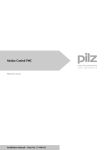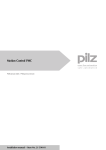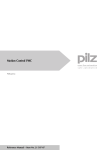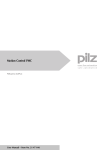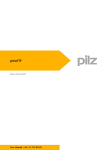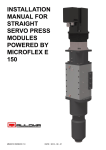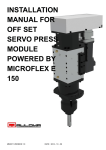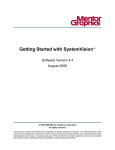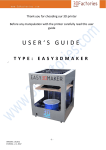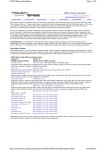Download Motion Control PMC
Transcript
Motion Control PMC PMCprimo 16+ Installation Manual – Item No. 21 484-05 1 General conditions 1. General conditions 1.1. Copyright Copyright 2005 Pilz GmbH & Co. KG All rights reserved. No part of this document may be reproduced in any form (print, photocopy, microfilm or any other format), or modified, duplicated by electronic means, without written authorization by Pilz GmbH & Co. KG. 1.2. Notes Pilz GmbH & Co. KG reserves the right to make amendments to this document at any time. The examples given serve only as illustrations. No guarantee is given for their suitability in particular applications. Although the utmost care has been taken in the production of this document, no liability can be accepted for any mistakes that it may contain. We welcome any suggestions for the improvement of our products, or documentation. We reserve the right to make technical changes, which lead to the improvement of the product! 1.3. Previous editions Edition V1 V2 V3 V4 V5 Page 2 Comments Initial issue ATEX note added Buffer battery, battery change, battery warning notice Modem cable Revision Installation manual PMCprimo 16+ 2 Table of contents 2. Table of contents 1. General conditions ......................................................................................................2 1.1. 1.2. 1.3. Copyright ............................................................................................................................ 2 Notes .................................................................................................................................. 2 Previous editions ................................................................................................................ 2 2. Table of contents .........................................................................................................3 3. Type key .......................................................................................................................5 4. Safety instructions ......................................................................................................6 5. European directives and standards...........................................................................7 6. Abbreviations and symbols........................................................................................8 7. General .........................................................................................................................9 7.1. About this manual............................................................................................................... 9 7.2. Requirements ..................................................................................................................... 9 7.3. Prescribed use (Use as directed) of the control.................................................................. 9 7.4. Instrument description ........................................................................................................ 10 7.4.1. Scope of delivery ........................................................................................................ 10 7.4.2. Accessories ................................................................................................................ 10 7.4.3. The digital control “PMCprimo 16+”............................................................................ 11 7.4.3.1. Performance data .............................................................................................. 11 7.4.3.2. Fieldbus modules............................................................................................... 11 7.4.3.3. Interfaces ........................................................................................................... 11 7.4.3.4. Soft-PLC CoDeSys® (option) ............................................................................. 11 7.4.3.5. Power supply ..................................................................................................... 11 7.4.3.6. Operation and programming .............................................................................. 11 7.5. Block diagram..................................................................................................................... 12 7.6. Example of use................................................................................................................... 13 7.7. Technical data .................................................................................................................... 14 7.7.1. Permissible ambient conditions, ventilation, mounting position .................................. 15 7.7.2. Conductor cross-sections ........................................................................................... 15 7.7.3. LED-Display ............................................................................................................... 15 7.7.4. Grounding system ...................................................................................................... 15 8. Installation....................................................................................................................16 8.1. Important instructions ......................................................................................................... 16 8.2. Assembly ............................................................................................................................ 17 8.2.1. Dimensions................................................................................................................. 17 8.2.2. Assembly inside switch cabinet .................................................................................. 18 8.3. Wiring ................................................................................................................................. 19 8.3.1. Connection diagram – motors and encoders.............................................................. 21 8.3.2. Connection diagram – digital I/O and communication ................................................ 22 8.3.3. Pin assignments - overview........................................................................................ 23 8.3.4. Pin assignments – top view ........................................................................................ 24 8.3.5. Pin assignments – front view...................................................................................... 25 9. Interfaces......................................................................................................................26 9.1. Power supply ...................................................................................................................... 26 9.1.1. CPU power supply 24V .............................................................................................. 26 9.1.2. Encoder power supply ................................................................................................ 27 9.1.3. Digital I/O power supply.............................................................................................. 28 9.1.4. Shielding..................................................................................................................... 29 9.2. Programming interfaces ..................................................................................................... 30 9.2.1. RS-232 interface......................................................................................................... 30 9.2.1.1. General .............................................................................................................. 30 9.2.1.2. Pin assignment cable......................................................................................... 30 9.2.1.3. Connection via RS232 ....................................................................................... 31 9.2.2. Ethernet interface ....................................................................................................... 32 9.2.2.1. General .............................................................................................................. 32 Installation manual PMCprimo 16+ Page 3 2 Table of contents 9.2.2.2. Interface............................................................................................................. 32 9.2.2.3. Setting the IP address........................................................................................ 33 9.3. Digital signals ..................................................................................................................... 34 9.3.1. Digital inputs I1:1 – I2:8 .............................................................................................. 34 9.3.2. Digital outputs O1:1 – O2:8 ........................................................................................ 35 9.4. Analog signals .................................................................................................................... 36 9.4.1. Analog outputs AO1 and AO2 .................................................................................... 36 9.4.2. Analog inputs AI1 and AI2 .......................................................................................... 37 9.5. Relay outputs...................................................................................................................... 38 9.6. Encoder inputs.................................................................................................................... 39 9.6.1. Incremental encoder................................................................................................... 40 9.6.2. Absolute encoder (SSI) .............................................................................................. 41 9.7. Bus interface (MODBUS / Profibus DP-S small)................................................................. 42 9.7.1. General....................................................................................................................... 42 9.7.2. Interface ..................................................................................................................... 42 9.7.3. Bus interface Profibus DP-S small.............................................................................. 43 9.7.4. Using the MODBUS / Profibus interface with PMCprimo............................................ 43 9.8. CAN bus interface .............................................................................................................. 44 9.8.1. General....................................................................................................................... 44 9.8.2. Linking PMCprimo-motion control systems (CAN –1)................................................. 44 9.8.3. CAN bus cable............................................................................................................ 45 9.8.4. Speciality 1st node ..................................................................................................... 45 9.8.5. Speciality last node..................................................................................................... 45 9.8.6. CAN-cable and accessories ....................................................................................... 45 9.8.7. Fault detection ............................................................................................................ 45 9.8.8. Connecting external CANopen bus devices (CAN-1 or CAN-2) ................................. 46 9.9. Compact Flash interface..................................................................................................... 47 9.10. Virtual inputs and outputs ................................................................................................... 47 9.10.1. Terms ........................................................................................................................ 47 9.10.2. Application example .................................................................................................. 47 9.11. Fieldbus interface ............................................................................................................... 48 9.11.1. General...................................................................................................................... 48 9.11.2. Using the fieldbus with PMCprimo............................................................................. 48 9.11.3. Example Profibus DP slave module .......................................................................... 48 10. Commissioning............................................................................................................50 10.1. Important notes................................................................................................................... 50 10.1.1. Error messages .................................................................................................................. 51 10.1.2. Error codes ................................................................................................................ 51 10.1.3. Error numbers on LED display................................................................................... 51 10.2. Status messages ................................................................................................................ 52 10.2.1. Status codes.............................................................................................................. 52 10.2.2. Status codes on LED display..................................................................................... 52 11. Appendix ......................................................................................................................53 11.1. Replacement of the buffer-battery ...................................................................................... 53 11.2. Removing faults.................................................................................................................. 54 11.3. Transport, storage, maintenance, disposal......................................................................... 55 12. Index .............................................................................................................................56 Page 4 Installation manual PMCprimo 16+ 3 Type key 3. Type key The nameplate depict below describes the various configurations of the PMCprimo 16+. Installation manual PMCprimo 16+ Page 5 4 Safety instructions 4. Page 6 Safety instructions • Electronic devices are not totally fail-safe • Only properly qualified personnel are permitted to perform activities such as transport, installation, commissioning and maintenance. Properly qualified persons are those who are familiar with the transport, assembly, installation, commissioning and operation of the product, and who have the appropriate qualifications for their job. The qualified personnel must know and observe: IEC 364 and CENELEC HD 384 or DIN VDE 0100 IEC-Report 664 or DIN VDE 0110 National Accident Prevention Regulations or BGV A2 • Read this documentation before carrying out installation and commissioning. Incorrect handling of the control system can lead to personal injury or material damage. It is vital that you keep to the technical data and information on connection requirements (on the nameplate and in the documentation). • The control contains electrostatically sensitive components which may be damaged by incorrect handling. Discharge your body before touching the control. Avoid contact with highly insulating materials (artifical fabrics, plastic film etc.). Place the control on a conductive surface. • Keep all covers and switchgear cabinet doors closed during operation. Otherwise there are deadly hazards, with the possibility of severe danger to health or material damage. • Never undo the electrical connections to the control while it is live. There is a danger of electric arcing with damage to contacts and danger to persons. • Note: This device contains a lithium-battery. Possible dangers: Fire, explosion and severe burn hazard. Do not recharge, disassemble, heat above 100 °C, incinerate or expose contents to water. Installation manual PMCprimo 16+ 5 European directives and standards 5. European directives and standards PMCprimo-controls are components which are intended to be incorporated into electrical plants and machines for industrial use. When the controls are built into machines or plants, the intended operation of the control is forbidden until it has been established that the machine or plant fulfills the requirements of the EC Directive on Machines (98/37 EC) and the EC Directive on EMC (89/336/EEC). EN 60204 and EN 292 must also be observed. The PMCprimo 16+ complies the product standard EN61131-2 “programmable controllers”. The manufacturer of the machine or plant is responsible for ensuring that they meet the limits which are required by the EMC regulations. Advice on the correct installation for EMC - such as shielding, grounding, arrangement of filters, treatment of connectors and the laying out of cabling - can be found in this documentation. • CE- conformance Conformance with the EC Directive on EMC 89/336/EEC and the Low Voltage Directive 73/23/EEC is mandatory for the supply of controls within the European Community. The controls of the PMCprimo-motion control series have been tested by an authorized testing laboratory in a defined configuration with the system components which are described in this documentation. Any divergence from the configuration and installation described in this documentation means that you will be responsible for the performance of new measurements to ensure that the regulatory requirements are met. • UL and cUL- conformance (I. quarter 2004) UL (cUL)-certified controls (Underwriters Laboratories Inc.) fulfil the relevant U.S. and Canadian standard (in this case UL 840 and UL 508C). This standard describes the fulfillment by design of minimum requirements for electrically operated power conversion equipment, such as frequency converters and servo amplifiers, which is intended to eliminate the risk of fire, electric shock, or injury to persons, being caused by such equipment. The technical conformance with the U.S. and Canadian standard is determined by an independent UL (cUL) fire inspector through the type testing and regular check-ups. Apart from the notes on installation and safety in the documentation, the customer does not have to observe any other points in direct connection with the UL (cUL)-certification of the equipment. UL 508C UL 508C describes the fulfillment by design of minimum requirements for electrically operated power conversion equipment, such as frequency converters and servo amplifiers, which is intended to eliminate the risk of fire being caused by such equipment. UL 840 UL 840 describes the fulfillment by design of air and insulation creepage spacings for electrical equipment and printed circuit boards. Note: Based on the guideline 94/9/EC (ATEX guideline) this product is not suitable for the application in potential explosive areas without evaluation of the conformity. Installation manual PMCprimo 16+ Page 7 6 Abbreviations and symbols 6. Abbreviations and symbols The abbreviations used in this manual are explained in the table below. Abbr. CAN CAN-GND CE CNC-GND COM DGND DIN EMC EN ESD GND IEC MODBUS RS232 RS422 RJ-45 SPS SSI UL V AC V DC VDE Meaning Controller area network- network system Ground CAN bus Communité Europeenne Ground PLC/control Serial interface for a PC-AT Digital ground, extern (for digital I/O, encoder) Deutsches Institut für Normung Electromagnetic compatibility European standard Electrostatic discharge Analog ground, internal (CPU) International Electrotechnical Commission Serial protocol for panels Serial interface, full duplex, Serial interface, full duplex, differential Interface for network connections (10BaseT) Speicherprogrammierbare Steuerung Synchron serial interface Underwriter Laboratory AC voltage DC voltage Verein deutscher Elektrotechniker danger to personnel from electricity and its effects gerneral warning mechanical hazard general instructions Page 8 ⇒ page see page (cross reference) • special emphasis Installation manual PMCprimo 16+ 7 General 7. General 7.1. About this manual This manual describes the digital contol system PMCprimo 16+. Here you can find information about: • Technical data from page 14 • Assembly and installation from page 16 • Interfaces from page 26 • Commissioning from page 48 • Error diagnostics from page 50 The programming of the PMCprimo-motion control-systems is described explicitely in the PMCprimo programming manuals: • for standard programming: PMCprimo programming manual • for IEC-61131-3 programming by CoDeSys: user manual for PMCprimo SoftPLC Useful hints about linking controls and CANopen devices via CAN bus can be found in the manual „PMCprimo CAN network“. Both manuals are part on the CD-ROM “Motion Control Tools”. 7.2. Requirements This manual makes the following demands on qualified personnel: Transport: only by personnel with knowledge in handling electrostatically sensitive components. Installation: only by electrically qualified personnel Commissioning: only by personnel with extensive knowledge of electrical engineering technology 7.3. Prescribed use (Use as directed) of the control The controls are components which are built into electrical equipment or machines, and can only be commissioned as integral components of such equipment. The controls may only be operated in a closed switchgear cabinet, taking into account the ambient conditions defined on page 15. Installation manual PMCprimo 16+ Page 9 7 General 7.4. 7.4.1. Instrument description Scope of delivery When you order a PMCprimo 16+ from us, you will receive: 7.4.2. • PMCprimo 16+ • Mating connectors X3, X4, X5, X6 • Installation manual • Software package CD-ROM “Motion Control Tools” • PMCprimo programming manual as well as further documentations in PDF format on CDROM Accessories The following accessories have to be ordered separately, if required: Page 10 • Encoder cable • MODBUS panel and MODBUS cable • Ethernet cable (10-BaseT) • Fieldbus module (see type key) • CAN cable • Communications cable to the PC (null modem cable) • Software keys for Motion Generator and Soft-PLC • Compact-Flash cards (type I or II) Installation manual PMCprimo 16+ 7 General 7.4.3. The digital control “PMCprimo 16+” 7.4.3.1. Performance data • Position controller with 1 ms cycle time • 20 axes in system: 18 real axes (8/16 digital with CAN + 2 analog) + 2 virtual axes • Each channel can operate in virtual motor mode • Software gearbox with mapping • Software differential and clutch • Internal map generation (motion generator) as an option • Product referencing • Tension control • 16 cam - free programmable • Soft positioning („S“-ramps) 7.4.3.2. Fieldbus modules • CAN bus with 500 kBit/s or 1 MBit/s(CANopen) – connecting up to 60 PMCprimo-motion control -systems • 2. CAN for interfacing CANopen devices like panels, encoders, I/O modules • Digital demand signals for the PMCtendo DD4 amplifier series via CAN • MODBUS interface – connection possibilities for operator panels • Ethernet interface (100 Mbit) • Fieldbus interface: Profibus DP (slave + master), Interbus S, DeviceNet (option) 7.4.3.3. Interfaces • 16 digital inputs, 24 V, electrically isolated (EN 61131-2) • 16 digital outputs, 24 V, short circuit protected and electrically isolated (EN 61131-2) • 2 analog outputs with ± 10 V range (demand signals) • 2 analog inputs with ± 10 V input range 7.4.3.4. Soft-PLC CoDeSys® (option) • Soft-PLC CoDeSys® (3S company) • Fully PLC functionality specified in IEC 61131-3 • PLC and PMCprimo-combined in one system • Programming system according to IEC 61131-3 7.4.3.5. Power supply • 24 V power supply for CPU and peripheral • 24 V power supply I/O • Common power supply for all encoders 7.4.3.6. Operation and programming • Comfortable programming with the software package “Motion Control Tools”. Fully programmable with any ASCII-Terminal. Installation manual PMCprimo 16+ Page 11 7 General 7.5. Block diagram Overview: All I/O signals. Page 12 Installation manual PMCprimo 16+ 7 General 7.6. Example of use Installation manual PMCprimo 16+ Page 13 7 General 7.7. Technical data PMCprimo 16+ Rated data DIM Supply voltage CPU Power dissipation (no load) Power supply I/O Power supply encoder Power supply CAN V= W V= V= 24 max. 16 24 5..24 V (external supply) internal Bit V Analog inputs (X3) Resolution Voltage range (ref. to GND) Input resistance kΩ 12 ±10 122 Digital inputs (X5) Reference inputs (X5 Pin 1-4) Inputs (X5 Pin 5-16) V V low 0...11 / high 11...24 low 0...11 / high 11...24 Ω MHz ns kHz V 400 Encoder inputs (X7, X9, X10) Input resistance Transfer rate (max.) Pulse width (Z track incremental encoder) Frequency SSI-Clock Signal level Analog outputs (X3) Resolution Voltage range (ref. to GND) Output resistance max. output current each channel Digital outputs (X5) Output resistance Page 14 Bit V Ω mA 1 min. 200 100/300 5 (TTL) 12 ±10 170 10 max. output current each output Ω mA 100 Supply current 24 V CPU 24 V I/O, each inputs, no load Supply current encoder 12V supply CAN, each node mA mA mA max. 700 20 see encoder datasheet 10 per node Connections Power supply (X4) Analog I/O (X3) Digital I/O (X5, X6) Ethernet (X2) RS232 (X1), CAN Out (X11) MODBUS (X8), encoders (X7,X9,X10) CAN In (X12) — — — — — — — Combicon 5,08 / 4 pole , 2,5mm² Combicon 5,08 / 6 pole , 2,5mm² Combicon 5,08 / 8 pole , 2,5mm² RJ45 plug (10 Base T) SUB-D 9pole (plug) SUB-D 9pole (socket) SUB-D 9pole (socket) Mechanical Weight Heigth without connectors Width Depth without connectors kg mm mm mm 2 317 64 185 <1 Installation manual PMCprimo 16+ 7 General 7.7.1. Permissible ambient conditions, ventilation, mounting position PMCprimo 16+ Storage temperature,-humidity, duration Supply voltage tolerances Supply voltage CPU Supply voltage I/O Supply voltage encoder Supply voltage CAN Ambient temperature in operation Humidity in operation Pollution level Enclosure protection Overvoltage category Max. positioning level Mounting position Vibration Ventilation —25...+55°C, max. 20K/hour rate of change rel. humidity max. 95 %, no condensation (⇒ page 55) 24 V DC (-10% +15%) 24 V DC (-10% +15%) see datasheet (with 5 V supply: -0%!) 12 V DC (-0% +15%), for long cables check voltage drop! 0...+45°C rel. humidity 95%, no condensation Pollution level 2 to VDE0100 IP 20 II 3000m generally vertikal. ⇒ page 17 Please contact our applications department! convection Make sure that there is sufficient forced ventilation within the switchgear cabinet! 7.7.2. Conductor cross-sections We recommend for PMCprimo 16+: Encoder Analog in- and outputs Digital I/O Serial I/O (RS232, MODBUS, CAN) Power supply, ground 7.7.3. 10x0,14 mm² twisted pairs, shielded, capacitance <120pF/m 0,25 mm² , twisted pairs, shielded 0,5 mm² 6x0,14 mm², shielded max. 2,5 mm², check voltage drop! LED-Display A four character LED display shows the current status of each channel (⇒ page 51) after system power on. Each error will be indicated with an error number (⇒ page 50). 7.7.4. Grounding system GND DGND Ground for analog in-/outputs, RS232, MODBUS, internal voltages (CPU) Ground for digital in-/outputs, 24 V I/O, encoder signals, CAN, optically and inductively isolated The potential isolation is shown in the block diagram (⇒ page 12). Installation manual PMCprimo 16+ Page 15 8 Installation 8. Installation 8.1. Important instructions Read this instructions manual carefully. Check the components supplied – do they match those ordered? Protect the control from impermissible stresses. In particular, do not let any components become bent or any insulation distances altered during transport and handling. Avoid contact with electronic components and contacts. The external fusing of the 24 V supply and the encoder supply is installed by the user. Take care that the control is earthed properly. Do not use painted (non-conductive) mounting plates. Route power and control cables separately. We recommend a separation of at least 20 cm. This improves the interference immunity required by EMC regulations. Install all shielding with large areas (low impedance), with metallized connector housings or shield connection clamps where possible. Ensure that there is an adequate flow of cool, filtered air into the bottom of the switchgear cabinet. See page 14. The programming has to be done by qualified personnel only. Caution Never disconnect the electrical connections to the control while it is live. In un-favourable circumstances this could result in destruction of the electronics. Page 16 Installation manual PMCprimo 16+ 8 Installation 8.2. 8.2.1. Assembly Dimensions • Dimension of the PMCprimo 16+ -housing (HxWxD) 317 x 64 x 185 mm • Distance of mounting holes: 300 mm • Diameter mounting holes: 8 mm All dimensions in mm. Installation manual PMCprimo 16+ Page 17 8 Installation 8.2.2. Assembly inside switch cabinet Material: 2 hexagon socket screws DIN 912, M5 Tool required: 4 mm Allen key Page 18 Installation manual PMCprimo 16+ 8 Installation 8.3. Wiring Only professional staff who are qualified in electrical engineering are allowed to install the control. The installation procedure is described as an example. A different procedure may be sensible or necessary, depending on the application of the equipment. Caution! Only install and wire up the equipment when it is not live, i.e. when neither the mains power supply nor the 24 V auxiliary voltage nor the operating voltages of any other connected equipment is switched on. Take care that the cabinet is safely disconnected (with a lock-out, warning signs etc.). The individual voltages will be switched on for the first time during commissioning. Note ! The ground symbol ⊥, which you will find in all the wiring diagrams, indicates that you must take care to provide an electrically conductive connection with the largest possible area between the unit indicated and the mounting plate in the switchgear cabinet. This connection is for the effective grounding of HF interference, and must not be confused with the PE- symbol (a protective measure to EN 60204). Use the following connection diagrams: — — — — — — — — — — — Power supply: Shielding: Digital signals: Analog signal: Relay : Encoders: MODBUS / Profibus small interface: CAN bus interface: RS232 interface: Ethernet interface: Fieldbus interface: Installation manual PMCprimo 16+ page 26 page 44 page 28 page 36 page 44 page 39 page 41 page 44 page 44 page 44 page 48 Page 19 8 Installation The following notes should assist you to carry out the installation in a sensible sequence, without overlooking anything important. Site Ventilation Assembly Cable selection Grounding shielding Wiring Final check Page 20 In a closed switchgear cabinet. Observe technical data on page 14. The site must be free from conductive or corrosive materials. For the mounting position in the cabinet ⇒ page 18. Check that the ventilation of the control is unimpeded and keep within the permitted ambient temperature Ventilation ⇒ page 14. Keep the required space clear above and below the control ⇒ page 18. Assemble the control and power supply close together on the conductive, earthed mounting plate in the cabinet. Select cables according to EN 60204 ⇒ page 15. EMC-compliant shielding and grounding ( ⇒ page 21). Earth the mounting plate, motor housing and CNC-GND of the controls. — Route power leads and control cables separately. — Wire the relay contacts in series into the safety loop of the installation. — Connect the digital control inputs to the control. — Connect DGND. — Connect analog signals. — Connect encoders. — Connect 24 V I/O and encoder supply (for max. permissible voltage values ⇒ page 14). — Connect 24 V CPU supply (for max. permissible voltage values ⇒ page 14). — Connect PC (RS232/Ethernet) (⇒ page 30). — Final check of the implementation of the wiring, according to the wiring diagamms which have been used. Installation manual PMCprimo 16+ 8 Installation 8.3.1. Connection diagram – motors and encoders Installation manual PMCprimo 16+ Page 21 8 Installation 8.3.2. Page 22 Connection diagram – digital I/O and communication Installation manual PMCprimo 16+ 8 Installation 8.3.3. Pin assignments - overview This overview shows the position of each connector: The connectors are described on following pages: Connector see page X1 (RS 232) page 30 X2 (Ethernet) page 32 X3 (Analog I/O) page 36 X4 (Power Supply) page 26 X5 (Digital In) page 34 X6 (Digital Out) page 35 X7, X9, X10 (Encoder 1-3) page 39 X8 (MODBUS / Profibus DP-S small) page 42 X11, X12 (CANopen) page 44 X13 (Fieldbus) see *.pdf files on CD-ROM X14 (CompactFlash-Card) page 47 X15 (CAN-open) page 46 Note: The description of the 7-segment-display can be found starting from page 51. The description of the LED’s can be found on page 33 and 38. Installation manual PMCprimo 16+ Page 23 8 Installation 8.3.4. Page 24 Pin assignments – top view Installation manual PMCprimo 16+ 8 Installation 8.3.5. Pin assignments – front view Installation manual PMCprimo 16+ Page 25 9 Interfaces 9. Interfaces All important interfaces of the PMCprimo 16+ are shown in this chapter. The precise location of the connectors and terminals can be seen on page 24 and page 25. 9.1. 9.1.1. Power supply CPU power supply 24V • Connector X4 Pin 1+2 • Power supply for CPU and intergrated peripherals • Supply from an external 24V DC-power supply • Required current rating: ca. 0,7 A (see page 14) • Reference ground is GND (analog GND) • External fuse protection by the user • Integrated EMC filters • See important notes to commissioning (see page 50) Pin 1 2 Page 26 Description 24 V/0,7 A DC 0 V (analog ground) Installation manual PMCprimo 16+ 9 Interfaces 9.1.2. Encoder power supply • Connector X4 Pin 5+6 • Common power supply for all connected encoders • Voltage range: See encoder datasheet • Reference ground is DGND (Digital-GND) • External fusing provided by the user Pin 5 6 Installation manual PMCprimo 16+ Description 5 – 24 V DC (according to the encoder type) 0 V (digital ground) Page 27 9 Interfaces 9.1.3. Digital I/O power supply • Connector X4 Pin 7+8 • Power supply for the digital I/O • Supply from an external 24V DC-power supply • Required current rating depends from load on outputs (see page 14) • Reference ground is DGND (Digital-GND) • External fusing provided by the user Pin 7 8 Page 28 Description 24 V DC 0 V (digital ground) Installation manual PMCprimo 16+ 9 Interfaces 9.1.4. Shielding • Connector X4 Pin 3+4 • Shielding connectors are connectet with the housing • For connection of cable shieldings (e.g. analog signals, encoder) Pin 3 4 Installation manual PMCprimo 16+ Description Shielding Shielding Page 29 9 Interfaces 9.2. Programming interfaces 9.2.1. RS-232 interface 9.2.1.1. General The programming of the PMCprimo 16+ is done with the terminal PTerm on a Personal Computer (PC) or Laptop. PTerm is part of the “Motion Control Tools” and can be found on the enclosed CD-ROM. Connect the RS232 interface (X1) of the PMCprimo 16+ via a normal core to a free serial interface (COM1 or COM2) on the PC. 9.2.1.2. Pin assignment cable (View: looking at the face of the built-in SUB-D connectors, this corresponds to the solder side of the SUB-D sockets on the cable) Reference ground of the RS232 interface is GND (no galvanic isolation!). Pin 2 3 5 6 7 Page 30 Description RxD (Receive data) TxD (Send data GND (Reference ground) RTS (Hardware-handshake, for > 38400 baud) CTS (Hardware-handshake, for > 38400 baud) Installation manual PMCprimo 16+ 9 Interfaces 9.2.1.3. Connection via RS232 The following parameters are used (standard): • 9600 Baud • 8 data bits • 1 stop bit • No parity • XOn/XOff-software handshake With the command “BD” the communication rate can be changed (see PMCprimo programming manual). The hardware handshake can additionally activated with the “CD” command. With this, transmittals up to 115200 baud are possible. Set these parameters with PTerm (see PTerm programming manual): After clicking on Installation manual PMCprimo 16+ the connection will be made and programming can be started. Page 31 9 Interfaces 9.2.2. Ethernet interface 9.2.2.1. General As a fast alternative to slow RS232-transmission PMCprimo 16+ provides an Ethernet interface (RJ-45-plug, X2). With the terminal PTerm the control can be programmed with a data rate of 100 MBit/s. The PMCprimo 16+ can easily be integrated in an existing Ethernet network. 9.2.2.2. Interface Note! To connect a PC via Ethernet a cross linked cable (crossover) is needed. The depicted cable is only for use with a HUB. Page 32 Installation manual PMCprimo 16+ 9 Interfaces The two LEDs above the RJ45-plug indicate the actual status of the Ethernet transmission: Yellow LED (/LANLED): Transmit/receive data Green LED (/LINKLED): Connection to HUB/PC OK! 9.2.2.3. Setting the IP address To communicate with the PMCprimo 16+ via Ethernet, the IP address of the control has to be set. This will be done with the command “CD” (see PMCprimo programming manual): 0.1: cd 0.1: Actual configuration: Operate Mode: STANDALONE Actual IP address 10.10.180.101 Actual Netmask 255.0.0.0 Fieldbus In/Out length 50 words Change Operating Mode? Y/N: N Delete application data? Y/N: N Change Ethernet? Y/N: Y New IP address (10.10.180.101) ? 10.10.180.101 New Netmask (255.0.0.0) ? Change Ethernet? Y/N: N Change Fieldbus configuration? Y/N: N 0.1: Now you can connect with Ethernet using PTerm. After clicking on Installation manual PMCprimo 16+ the connection will be made and programming can be started. Page 33 9 Interfaces 9.3. 9.3.1. Digital signals Digital inputs I1:1 – I2:8 The digital inputs of the PMCprimo 16+ are electrically isolated through optocouplers. Page 34 • Connector X5 Pin 1-16 • Reference ground is DGND (Digital-GND, connector X4, Pin 6+8) • Input logic is PLC compatible (24V-level) according to EN 61131-2 • Logical high: +11..24V / logical low: 0 V .. 11 V • Fast response inputs I1:1 - I1:4 for e.g. product referencing • Actual input status is indicated through green LEDs Installation manual PMCprimo 16+ 9 Interfaces 9.3.2. Digital outputs O1:1 – O2:8 All digital outputs are electrically isolated and short circuit protected. • Connector X6 Pin 1-16 • Reference ground is DGND (Digital-GND, connector X4, Pin 6+8) • „High-Side“-outputs: 24V /0,1 A each output • Actual output status is indicated through red LEDs Installation manual PMCprimo 16+ Page 35 9 Interfaces 9.4. 9.4.1. Analog signals Analog outputs AO1 and AO2 Both analog outputs of the PMCprimo 16+ are normally used as demand outputs for the connected servo amplifiers, e.g. Pilz PMCtendo DD4. The demand output signals have a voltage range of ± 10 V. The analog outputs can be configured as auxiliary outputs. With the commands SF and AO (see PMCprimo programming manual) you can monitor several signals, e.g. demand position error. • Connector X3 Pin 3+9 • Reference ground is GND (analog-GND, connector X3 Pin 4+10) • No galvanic isolation • Voltage range: ± 10 V • Resolution: 12 Bit (4096 voltage levels) Pin 3 4 9 10 Page 36 Description AO1 (± 10 V) 0 V (analog ground) AO2 (± 10 V) 0 V (analog ground) Installation manual PMCprimo 16+ 9 Interfaces 9.4.2. Analog inputs AI1 and AI2 Both analog inputs of the PMCprimo 16+ are auxiliary inputs. They can be used e.g. for tension control. The input voltage range is ± 10 V. The current value of the analog input can be read with the command DA (see PMCprimo programming manual). • Connector X3 Pin 1+2 and Pin 7+8 • All signals are referred to AI1- resp. AI2-(connector X3 Pin 2 resp. Pin 8) • No galvanic isolation • Input voltage range : ± 10 V (ref. to AI1-/AI2-) • Resolution : 12 Bit (4096 voltage levels) Pin 1 2 7 8 Installation manual PMCprimo 16+ Description AI1+ (± 10 V) AI1- (Reference Ground for AI1+) AI2+ (± 10 V) AI2- (Reference Ground for AI2+) Page 37 9 Interfaces 9.5. Relay outputs The relay contacts NO and COM (X3 Pin 5+6 and Pin 11+12) are used to derive an enable signal to the servo amplifier for channel 1+2. The contacts are closed when position control on channel 1 or 2 are active (e.g. command PC). A motor error opens the relay contact and sets the demand output signal to 0V. Maximum load: Each contact 30V DC/1A. The red LEDs below the RJ45-plug X2 show the actual relay status: LED on: Contact closed, position control active LED off: Contact open, motor off state Pin 5 6 11 12 Page 38 Description NO1 (Normal open 1) COM1 (shared contact) NO2 (Normal open 2) COM2 (shared contact) Installation manual PMCprimo 16+ 9 Interfaces 9.6. Encoder inputs The PMCprimo 16+ is designed for use with up to three incremental or SSI encoders (X7, X9 and X10). The encoder type can easily be changed with the “FS” command. With SSI encoders the number of data bits can be set with the “NB” command. The logical sense of each encoder input can be changed with the command “CW”. Setting the direction bit reverses the direction of the encoder without wiring. If a reference signal occurs, the actual encoder position is stored (see reference inputs page 34). This is useful for product referencing. For further details see PMCprimo programming manual. A master encoder is normally connected at the encoder input of channel three. But with the “FC” command the encoder signals can be redirected to channel 1 or 2. All encoders have a common power supply with connector X4 (Pin 5+6). See also page 27. If encoders with different supply voltages should be connected, the encoder cables have to be modified. The two wires for supply voltage are connected with an external power supply (X7, X9, X10: Pin 4+9). The input configuration is designed for 5 V logic level. Exceeding this range will damage the input logic. Installation manual PMCprimo 16+ Page 39 9 Interfaces 9.6.1. Page 40 Incremental encoder • Reference ground is DGND (connector X4 Pin 6 + 8) • For encoders with differential line drivers – track A, B and Z (0-Index) • Quadrature encoder x1, x2 and x4 • Maximum input frequency: 1 Mhz • Minimum track width Z-track: 200 ns • Maximum voltage range ref. to DGND: 5 V DC (TTL) Installation manual PMCprimo 16+ 9 Interfaces 9.6.2. Absolute encoder (SSI) • Reference ground is DGND (connector X4 Pin 6 + 8) • Number of data bits: 13..32 • Format: Binary or gray • Frequency SSI-Clock: 100 kHz or 300 kHz (change with command FS, see PMCprimo programming manual) • Maximum voltage range ref. to DGND: 5 V DC (TTL) Note: Alternatively absolute encoder can be also connected by the CAN-open interfaces. Installation manual PMCprimo 16+ Page 41 9 Interfaces 9.7. 9.7.1. Bus interface (MODBUS / Profibus DP-S small) General As a comfortable way to set parameters the PMCprimo 16+ offers a MODBUS-interface (X8). You can directly connect our MODBUS-panels (e.g.PMI 315). In networked systems (CAN) the panel has to be connected to the host system. Only the host’s MODBUS-interface is active in this mode. The PMCprimo 16+ is equipped alternativ with MODBUS or Profibus DP-S small. The connection is done always by the connector X8. When using the option Profibus DP-S, the MODBUS is out of service. 9.7.2. Interface The communication uses a 5-core cable (RS422 full duplex). The communication parameters are: • 9600 Baud, 8N1, no handshake With the command “BM” the baud rate can be changed (see PMCprimo programming manual) Pin 2 3 5 7 8 Page 42 Description TxD (send data) RxD (receive data) 0 V (analog ground) /TxD (send data inverted) /RxD (receive data inverted) Installation manual PMCprimo 16+ 9 Interfaces 9.7.3. Bus interface Profibus DP-S small The setting for the Profibus parameters can be done with the “CD“ command (see PMCprimo programming manual). With the DIP-switches 3 and 4 the Profibus termination can be set. To activate the termination, both DIP-switches must set to ON. Pin 3 5 6 8 Description DP+ DP-GND 5V DP- The needed GSD-file (HMS_1810.GSD) is located on the CD-ROM (also see example 10.11.3) 9.7.4. Using the MODBUS / Profibus interface with PMCprimo With the MODBUS / Profibus up to 108 bus-variables (MODBUS), respective 16 bus-variables (Profibus DP-S small), can be read or write. • Notation: $B1 - $B108 (see PMCprimo programming manual „bus variables“) • Data bits : 16 Bit (=2 Bytes = 1 Word) signed. • Range: -32768 to 32767 (Hex: 0x8000 to 0x7FFF). Bus variables can be defined as trigger variables, so a program can be executed when the variable is updated. Installation manual PMCprimo 16+ Page 43 9 Interfaces 9.8. 9.8.1. CAN bus interface General With the CAN bus interface CAN-1A (X11) and CAN-1B (X12) up to 60 PMCprimo-motion controlsystems can be linked together. The bus speed is 500kBit/s. Additional safety signals provide fault detection. Much more details about linking CANopen devices are included in the manual „PMCprimo CANnetwork“. The manual is part of the enclosed CD-ROM “Motion Control Tools“. 9.8.2. Linking PMCprimo-motion control systems (CAN –1) On each system CAN-1A (X11) and CAN-1B (X12) of the next system are linked together in the way as shown below: Pin 1 2 3 4 6 7 9 Page 44 Description CAN Error (is switched against CAN-GND when failure) CAN-L CAN-GND Relais contacts (opened when failure) CAN-GND (connected internal with pin 3) CAN-H CAN-V+ (12 V-supply voltage) Installation manual PMCprimo 16+ 9 Interfaces 9.8.3. CAN bus cable The interface cable is a 1:1 connection (9-pole SUB-D socket to 9-pole SUB-D plug). • Characteristic impedance: 120 Ω • Cable capacitance : max. 60 nF/km • Lead resistance (loop):: 159,8 Ω/km • st Max. cable length : 70 m (1 . to last node ) For EMC reasons, the SUB-D connector housing must fulfill the following conditions: metal or metallized housingprovision for cable shielding connection in housing, large-area connection. You have to terminate the first and the last node (120 Ω ). 9.8.4. 9.8.5. Speciality 1st node • The 1st node is supplied at CAN-1A (X11, Pin 9) with +12V , at Pin 3 CAN-GND (0V). • Minimum power dissipation of the power supply unit: 1 VA each node. • An additional resistor 10 kΩ (250 mW, metall 1%) between Pin 1 and Pin 4 is necessary. Speciality last node The last node needs a jumper bridge (0 Ω) at CAN-In between Pin 4 and Pin 9. 9.8.6. CAN-cable and accessories Position CAN-connection cable (1:1) 700 mm CAN –feedlead 12 V Termination Power supply 12 V 9.8.7. item number 1803117 0802951 0802950 4803002 Fault detection The following faults will be detected: • Missing or defect +12V-CAN power supply • Malfunction of a bus node • Break of the CAN bus cable Installation manual PMCprimo 16+ Page 45 9 Interfaces 9.8.8. Connecting external CANopen bus devices (CAN-1 or CAN-2) It is possible to connect external CANopen devices with PMCprimo-motion control-systems. With e.g. a CAN-I/O module you can increase the number of inputs and outputs in the system. A CANopen encoder or CANopen panel can also be used. Hint: The terminators (120 Ω) for CAN-1 and CAN-2 can be activated via DIP-switches. For this example the DIP-switches 1 and 2 must be set to “ON”. The 12 V DC feed is not applicable by this kind of networking. For the wiring of the CAN-bus, cables from our standard program (see page 45) can be used. Page 46 Installation manual PMCprimo 16+ 9 Interfaces 9.9. Compact Flash interface With the Compact Flash interface an easy data exchange with other systems is possible. Standard CompactFlash cards type I + II can be used. You can receive further technical informations in the file “TI_CF_CARD_GB_001.pdf” on the CDROM. 9.10. Virtual inputs and outputs In addition to the real digital inputs and outputs there are 8 virtual inputs and 8 virtual outputs on each PMCprimo 16+ system. The virtual inputs and outputs don’t have any terminals. But all input and output commands are available (see PMCprimo programming manual). 9.10.1. Terms Virtual inputs: E3:1 – E3:8 Virtual outputs: O3:1 – O3:8 The virtual inputs an outputs are connected (internal) together as shown below: Output O3:1 with input E3:1 Output O3:2 with input E3:2 etc. 9.10.2. Application example You define a position output on the virtual output 0.3:2. If you define an input function on input 0.3:2, this program will be executed each time the output 0.3:2 is set. You don’t need any wiring! For further details see PMCprimo programming manual. Installation manual PMCprimo 16+ Page 47 9 Interfaces 9.11. 9.11.1. Fieldbus interface General At the fieldbus interface X13 several fieldbus modules can be mounted inside the PMCprimo 16+. There are modules for e.g. Profibus DP, DeviceNet or Interbus-S available (see type key page 5). The fieldbus modules are delivered already inserted. The original manufacturer’s documentation is enclosed (english language). It can be found on the CD-ROM „Motion Control Tools“ in PDF format. Additional files, e.g. GSD files (Profibus DP) are on the CD-ROM, too. 9.11.2. Using the fieldbus with PMCprimo With the fieldbus 108 bus variables can be used for data exchange (depending on the fieldbus module). 9.11.3. • Notation: $B1 - $B108 (see PMCprimo programming manual „bus variables“) • Data bits : 16 Bit (=2 Bytes = 1 Word) signed. • Range: -32768 to 32767 (Hex: 0x8000 to 0x7FFF). Example Profibus DP slave module After setting the slave address (turn switches on Profibus module) and termination (DIP-switch) PMCprimo 16+ can be powered on. Following message appears when the module is recognized. S T A R T Ser.Nr.:90, Version 1.006 May Operate Mode: HOST+NODE MOTION INSTALLED ETHERNET INSTALLED Profibus-DP-Module found Channel 0.1 found Channel 0.2 found Channel 0.3 found Channel 0.4 found 9 2001, 10:03:03 In this example the bus variables $B1 up to $B4 are read and written (4 Words = 8 Bytes at all). The configuration of the PMCprimo 16+ is done with the command CD. 0.1: cd 0.1: Actual configuration: Operate Mode: STANDALONE Actual IP address 10.10.180.101 Actual Netmask 255.0.0.0 Fieldbus In/Out length 50 words Change Operating Mode? Y/N: N Delete application data? Y/N: N Change Ethernet? Y/N: N Change Fieldbus configuration? Y/N: Y New In/Out length in words (50) ? 4 Change Fieldbus configuration? Y/N: N 0.1: Subsequent the Profibus-DP-Master hat to be configured to IN/OUT: 8 Byte (4 word). The GSD file is named: HMS_1003.gsd. Page 48 Installation manual PMCprimo 16+ 9 Interfaces Example: Profibus DP Master simulator: After starting the Profibus communication the red LED goes out and the green LED indicates a successful initialisation. Now bus variables can be set or read. Example: Setting the bus variable $B1 to value 100 (0x0064) 0.1: $B1=100 (0x00000064) If bus variables are defined as trigger variables (see PMCprimo programming manual), a program can be executed when the variable is updated. Installation manual PMCprimo 16+ Page 49 10 Commissioning 10. 10.1. Commissioning Important notes Only professional personnel with extensive knowledge in the fields of electrical/ drive technology are allowed to commission the control. The procedure for commissioning is described as an example. Depending on the application, a different procedure may be sensible or necessary. The following instructions should help you to carry out the commissioning in a sensible order, without any hazards to people or machinery. Check installation Power on the PC starte PTERM and connect to the control. Connect PC and control with serial cable (page 30) or Ethernet cable (page 32). Switch on the 24 V power supplies Switch on 24V CPU, 24V I/O, encoder supply and CAN supply (main switch). System is booting. Display status and error messages The control is ready to operate Page 50 Disconnect the control from power supply. After booting and initialisation(ca. 6s) status codes (page 51) and possible error codes (page 51) are showed on the LED-display. The programming is described detailed in the PMCprimo programming manual. Installation manual PMCprimo 16+ 10 Commissioning 10.1.1. Error messages Errors which occur are shown in coded form by an error number in the LED display on the front panel. All error messages are also displayed on the connected terminal program (e.g. PTERM) 10.1.2. Error codes number F01 F03 F04 F05 F06 F07 F13 BATT 10.1.3. meaning Position error High position limit Low position limit Reference timeout Reference out of limits Reference overrun Encoder timeout Buffer battery almost empty, should be replaced immediately Æ p. 53 Error numbers on LED display Example for an error number: Channel: 1 Error code F01: Position error Installation manual PMCprimo 16+ Page 51 10 Commissioning 10.2. Status messages The status of the particular axes as well as the current operating condition is also showed on the display. Every digit of the display corresponds on axis. The display shows 4 axes simultaneously in change. 10.2.1. Status codes Display P 0 1 2 4 5 6 7 9 A C 10.2.2. Meaning Command Position control mode PC Motor off mode MO Velocity control mode VC Moving to new position MA, MR Executing a position mapping XM Stopping under normal deceleration ST Initializing to reference position IN, IB Torque control mode AM, XM Waiting WA, WB, WI, etc. Alignment move XM Software clutch XM, ST Status codes on LED display Example of a status code: Page 52 Installation manual PMCprimo 16+ 11 Appendix 11. 11.1. Appendix Replacement of the buffer-battery The buffer-battery must be replaced, when the display shows the message “BATT”. With present 24 V supply voltage, the buffer content remains. Type of battery: CR2032 Procedure: 1. Connect the 24 V CPU-supply voltage (connector X4 pin 1+2) 2. Open the case (4 screws M3) 3. Change the battery (regard polarity) 4. Close the case 5. Checkup: the display message “BATT” expires and shows the actual status of the controller ESD! ESD ESDS : electrostatic discharge : electrostatic sensitive devices Motion control units contain electrostatic sensitive devices which will be damaged by electrostatic discharge. Therefore servicing shall only be performed in ESD safe areas and by ESD protected personnel. Installation manual PMCprimo 16+ Page 53 11 Appendix 11.2. Removing faults The table below will help you with common problems. Error possible causes LED display keeps — no power supply dark after power on — internal fuse damaged — system still booting no RS232— wrong COM port selected communication — wrong baud rate with BD in possible autostart program no Ethernet communication possible no encoder signals — wrong IP address or address reserved from other device — — — — missing encoder power supply channel in virtual mode wrong encoder type or data bits selected no encoder connected no digital outputs — missing I/O power supply available — output still defined as cam digital inputs can not be read motor goes in position error motor is moving in wrong direction Page 54 — — — — — — — — — short circuit voltage range to low short circuit input masked missing ground connection feedback setup incorrect no drive enable signal wrong control parameters (KP, KF) counting direction and sign of demand signal reversed Measures to remove the cause of the fault — connect 24 V-CPU supply watch power dissipation — open the housing and replace fuse — no error! Booting takes about 6 s. — Select right port in PTerm — select right baud rate in PTerm or press CTRL + E after power on and delete application data — change IP address — — — — — — — — — — — — — — — check power supply set channel to real mode with VM0 check values for FS and NB connect encoder (on the right channel) connect 24 V power supply, watch power dissipation redefine output with UO command remove short circuit min. voltage HIGH: 18 V remove circuit enable input with EI command connect ground change control word CW check wiring set parameters to default change control word CW Installation manual PMCprimo 16+ 11 Appendix 11.3. Transport, storage, maintenance, disposal Transport: — — — — — — only by qualified personnel only in the manufacturer’s original recyclable packaging avoid shocks Temperature -25...+70°C, max. 20K / hour rate of change Humidity max. 95% relative humidity, no condensation The PMCprimo 16+ contain electrostatically sensitive components which can be damaged by incorrect handling. Discharge yourself before touching the control. Avoid contact with highly insulating materials (artificial fabrics, plastic films etc.). — — Place the PMCprimo 16+ on a conductive surface. if the packaging is damaged, check the unit for visible damage. In this case, inform the shipper and the manufacturer. Maintenance: — — the instruments do not require any maintenance opening the enclosure invalidates the warranty Cleaning : if the casing is dirty, clean with Isopropanol or similar cleaning agent do not immerse or spray dirt inside the unit must be cleaned by the manufacturer — — Disposal : — — Installation manual PMCprimo 16+ the PMCprimo 16+ can be reduced to its principal components by removing the screws(steel-housing, electronic boards) disposal should be carried out by a certified disposal company. Page 55 12 Index 12. Index A Abbreviations ............................................................... 8 Accessories................................................................ 10 Appendix .................................................................... 53 Assembly inside switch cabinet.................................. 18 B Block diagram ............................................................ 12 C CAN bus cable................................................................ 45 bus speed............................................................... 44 capacitance ............................................................ 45 encoder .................................................................. 46 fault detection......................................................... 45 I/O module.............................................................. 46 impedance.............................................................. 45 max. cable length ................................................... 45 CAN-cable and accessories ....................................... 45 ce- conformance .......................................................... 7 CoDeSys .................................................................... 11 Comissioning.............................................................. 50 Conductor cross-sections........................................... 15 Copyright...................................................................... 2 D Dimensions ................................................................ 17 Disposal ..................................................................... 55 E Encoder absolute encoder.................................................... 41 incremental encoder............................................... 40 signal level ............................................................. 39 Error codes................................................................. 51 Error messages.......................................................... 51 Ethernet connecting PTerm .................................................. 33 interface ................................................................. 32 IP address .............................................................. 33 LEDs ...................................................................... 33 Example of use .......................................................... 13 F Faults ......................................................................... 54 G Grounding system ...................................................... 15 I Inputs analog .................................................................... 37 digital...................................................................... 34 Page 56 encoder .................................................................. 39 virtual...................................................................... 47 Installation .................................................................. 16 important instructions ............................................. 16 Instrument description ................................................ 10 Interfaces 24V-supply digital I/O ............................................. 28 absolute encoder .................................................... 41 analog inputs .......................................................... 37 analog outputs ........................................................ 36 CAN bus ................................................................. 44 digital inputs ........................................................... 34 digital outputs ......................................................... 35 Ethernet interface ................................................... 32 fieldbus interface .................................................... 48 incremental encoder ............................................... 40 MODBUS................................................................ 42 Profibus DP ............................................................ 48 relay outputs........................................................... 38 RS232 interface...................................................... 30 shielding ................................................................. 29 IP address .................................................................. 33 L LED display .................................................... 15, 51, 52 M MODBUS bus variables .......................................................... 48 interface.................................................................. 42 O Outputs analog..................................................................... 36 digital ...................................................................... 35 relay outputs........................................................... 38 virtual...................................................................... 47 P Pin assignments front view ................................................................ 25 top view .................................................................. 24 Power supply.............................................................. 26 Prescribed use ............................................................. 9 Profibus DP-S............................................................. 42 PTERM....................................................................... 51 R RS232 interface.................................................................. 30 modem cable.......................................................... 30 parameter ............................................................... 31 S Safety instructions ........................................................ 6 Scope of delivery........................................................ 10 Soft-PLC..................................................................... 11 Installation manual PMCprimo 16+ Index Status codes .............................................................. 52 Status messages........................................................ 52 Storage....................................................................... 55 T Technical data............................................................ 14 Transport.................................................................... 55 Type key....................................................................... 5 Installation manual PMCprimo 16+ U UL- conformance.......................................................... 7 W Wiring ......................................................................... 19 Page 57 21 484-05, 2007-02 Printed in Germany


























































